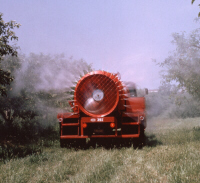Unfortunately, there are few general rules for managing fungicide resistance.
First, the fungicides themselves vary widely in their biochemical modes
of action and the spectrum of organisms against which they are effective.
Secondly, different fungi differ widely in their capacity to produce fungicide
resistant biotypes. If we truly want to manage resistance, we must consider
each fungus and each fungicide on a case-by-case basis.

There are several factors that affect the rate at which the frequency
of fungicide resistance increases to the point where disease control becomes
a problem. The first is the initial frequency of resistant individuals
in the fungal population. It matters little whether those individuals existed
before the fungicide was used or whether a fungicide-resistant biotype arose
by a chance mutation some time after the fungicide had been in use. In either
case, what is important is the proportion of the propagules of the fungus that
are of the resistant (or, if you prefer, "less sensitive") biotype at any point
in the epidemic.
The second factor is the rate of selection of the resistant biotype,
that is, its relative success in surviving and reproducing (compared with
the sensitive biotype) in the presence of the fungicide. This is affected
by the dose of the fungicide (the higher the dose, the less chance for
"escapes" of the sensitive biotype) and by the level of resistance expressed
in the resistant biotype. For example, if the lethal dose for the resistant
biotype were 100 times that required for the "wild type", we would expect
to see a faster rate of selection than if the resistant biotype were
killed by only twice the dose required to kill the wild type.
The third factor is the fitness of the resistant biotype relative to the
sensitive biotype in the absence of the fungicide. This affects the rate at
which the resistant population "reverts" to the wild type without continued
selection by the fungicide to which it is resistant. The effect of fungicide
resistance on the fitness of the fungus varies quite widely, depending on the
biochemical basis of resistance. For example, many fungi resistant to benomyl
seem to be nearly as ecologically fit as their benomyl-sensitive counterparts,
whereas some of the fungi resistant to some of the dicarboximide fungicides
appear to gain that resistance only at great metabolic cost, and they are far
less able to compete in the absence of the fungicide than are their
corresponding wild types.